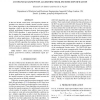8118 search results - page 3 / 1624 » The Newton Application Architecture |
ASAP
2005
IEEE
13 years 11 months ago
2005
IEEE
With continued reductions in feature size, additional functionality may be added to future microprocessors to boost the performance of important application domains. Due to growth...
ASAP
2004
IEEE
13 years 9 months ago
2004
IEEE
Decreasing feature sizes allow additional functionality to be added to future microprocessors to improve the performance of important application domains. As a result of rapid gro...
ICASSP
2010
IEEE
13 years 5 months ago
2010
IEEE
In the last decade various time- and frequency-domain algorithms were derived to blindly identify acoustic systems. One of these algorithms is the multichannel Newton (MCN) algori...
CORR
2011
Springer
13 years 13 days ago
2011
Springer
Abstract An extension of the Gauss-Newton algorithm is proposed to find local minimizers of penalized nonlinear least squares problems, under generalized Lipschitz assumptions. Co...
ICDM
2006
IEEE
13 years 11 months ago
2006
IEEE
— Log-linear models are widely used for labeling feature vectors and graphical models, typically to estimate robust conditional distributions in presence of a large number of pot...

